Wenbo Su
MeSH: Memory-as-State-Highways for Recursive Transformers
Oct 09, 2025Abstract:Recursive transformers reuse parameters and iterate over hidden states multiple times, decoupling compute depth from parameter depth. However, under matched compute, recursive models with fewer parameters often lag behind non-recursive counterparts. By probing hidden states, we trace this performance gap to two primary bottlenecks: undifferentiated computation, where the core is forced to adopt a similar computational pattern at every iteration, and information overload, where long-lived and transient information must coexist in a single hidden state. To address the issues, we introduce a Memory-as-State-Highways (MeSH) scheme, which externalizes state management into an explicit memory buffer and employs lightweight routers to dynamically diversify computation across iterations. Probing visualizations confirm that MeSH successfully resolves the pathologies by inducing functional specialization across iterations. On the Pythia suite (160M-1.4B), MeSH-enhanced recursive transformers consistently improve over recursive baselines and outperforms its larger non-recursive counterpart at the 1.4B scale, improving average downstream accuracy by +1.06% with 33% fewer non-embedding parameters. Our analysis establishes MeSH as a scalable and principled architecture for building stronger recursive models.
Asymmetric Proximal Policy Optimization: mini-critics boost LLM reasoning
Oct 02, 2025Abstract:Most recent RL for LLMs (RL4LLM) methods avoid explicit critics, replacing them with average advantage baselines. This shift is largely pragmatic: conventional value functions are computationally expensive to train at LLM scale and often fail under sparse rewards and long reasoning horizons. We revisit this bottleneck from an architectural perspective and introduce Asymmetric Proximal Policy Optimization (AsyPPO), a simple and scalable framework that restores the critics role while remaining efficient in large-model settings. AsyPPO employs a set of lightweight mini-critics, each trained on disjoint prompt shards. This design encourages diversity while preserving calibration, reducing value-estimation bias. Beyond robust estimation, AsyPPO leverages inter-critic uncertainty to refine the policy update: (i) masking advantages in states where critics agree and gradients add little learning signal, and (ii) filtering high-divergence states from entropy regularization, suppressing spurious exploration. After training on open-source data with only 5,000 samples, AsyPPO consistently improves learning stability and performance across multiple benchmarks over strong baselines, such as GRPO, achieving performance gains of more than six percent on Qwen3-4b-Base and about three percent on Qwen3-8b-Base and Qwen3-14b-Base over classic PPO, without additional tricks. These results highlight the importance of architectural innovations for scalable, efficient algorithms.
Part I: Tricks or Traps? A Deep Dive into RL for LLM Reasoning
Aug 11, 2025Abstract:Reinforcement learning for LLM reasoning has rapidly emerged as a prominent research area, marked by a significant surge in related studies on both algorithmic innovations and practical applications. Despite this progress, several critical challenges remain, including the absence of standardized guidelines for employing RL techniques and a fragmented understanding of their underlying mechanisms. Additionally, inconsistent experimental settings, variations in training data, and differences in model initialization have led to conflicting conclusions, obscuring the key characteristics of these techniques and creating confusion among practitioners when selecting appropriate techniques. This paper systematically reviews widely adopted RL techniques through rigorous reproductions and isolated evaluations within a unified open-source framework. We analyze the internal mechanisms, applicable scenarios, and core principles of each technique through fine-grained experiments, including datasets of varying difficulty, model sizes, and architectures. Based on these insights, we present clear guidelines for selecting RL techniques tailored to specific setups, and provide a reliable roadmap for practitioners navigating the RL for the LLM domain. Finally, we reveal that a minimalist combination of two techniques can unlock the learning capability of critic-free policies using vanilla PPO loss. The results demonstrate that our simple combination consistently improves performance, surpassing strategies like GRPO and DAPO.
RecGPT Technical Report
Jul 30, 2025



Abstract:Recommender systems are among the most impactful applications of artificial intelligence, serving as critical infrastructure connecting users, merchants, and platforms. However, most current industrial systems remain heavily reliant on historical co-occurrence patterns and log-fitting objectives, i.e., optimizing for past user interactions without explicitly modeling user intent. This log-fitting approach often leads to overfitting to narrow historical preferences, failing to capture users' evolving and latent interests. As a result, it reinforces filter bubbles and long-tail phenomena, ultimately harming user experience and threatening the sustainability of the whole recommendation ecosystem. To address these challenges, we rethink the overall design paradigm of recommender systems and propose RecGPT, a next-generation framework that places user intent at the center of the recommendation pipeline. By integrating large language models (LLMs) into key stages of user interest mining, item retrieval, and explanation generation, RecGPT transforms log-fitting recommendation into an intent-centric process. To effectively align general-purpose LLMs to the above domain-specific recommendation tasks at scale, RecGPT incorporates a multi-stage training paradigm, which integrates reasoning-enhanced pre-alignment and self-training evolution, guided by a Human-LLM cooperative judge system. Currently, RecGPT has been fully deployed on the Taobao App. Online experiments demonstrate that RecGPT achieves consistent performance gains across stakeholders: users benefit from increased content diversity and satisfaction, merchants and the platform gain greater exposure and conversions. These comprehensive improvement results across all stakeholders validates that LLM-driven, intent-centric design can foster a more sustainable and mutually beneficial recommendation ecosystem.
Reinforcement Learning Optimization for Large-Scale Learning: An Efficient and User-Friendly Scaling Library
Jun 06, 2025Abstract:We introduce ROLL, an efficient, scalable, and user-friendly library designed for Reinforcement Learning Optimization for Large-scale Learning. ROLL caters to three primary user groups: tech pioneers aiming for cost-effective, fault-tolerant large-scale training, developers requiring flexible control over training workflows, and researchers seeking agile experimentation. ROLL is built upon several key modules to serve these user groups effectively. First, a single-controller architecture combined with an abstraction of the parallel worker simplifies the development of the training pipeline. Second, the parallel strategy and data transfer modules enable efficient and scalable training. Third, the rollout scheduler offers fine-grained management of each sample's lifecycle during the rollout stage. Fourth, the environment worker and reward worker support rapid and flexible experimentation with agentic RL algorithms and reward designs. Finally, AutoDeviceMapping allows users to assign resources to different models flexibly across various stages.
Weight Spectra Induced Efficient Model Adaptation
May 29, 2025Abstract:Large-scale foundation models have demonstrated remarkable versatility across a wide range of downstream tasks. However, fully fine-tuning these models incurs prohibitive computational costs, motivating the development of Parameter-Efficient Fine-Tuning (PEFT) methods such as LoRA, which introduces low-rank updates to pre-trained weights. Despite their empirical success, the underlying mechanisms by which PEFT modifies model parameters remain underexplored. In this work, we present a systematic investigation into the structural changes of weight matrices during fully fine-tuning. Through singular value decomposition (SVD), we reveal that fine-tuning predominantly amplifies the top singular values while leaving the remainder largely intact, suggesting that task-specific knowledge is injected into a low-dimensional subspace. Furthermore, we find that the dominant singular vectors are reoriented in task-specific directions, whereas the non-dominant subspace remains stable. Building on these insights, we propose a novel method that leverages learnable rescaling of top singular directions, enabling precise modulation of the most influential components without disrupting the global structure. Our approach achieves consistent improvements over strong baselines across multiple tasks, highlighting the efficacy of structurally informed fine-tuning.
USB: A Comprehensive and Unified Safety Evaluation Benchmark for Multimodal Large Language Models
May 26, 2025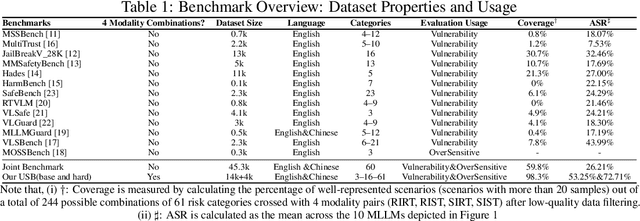
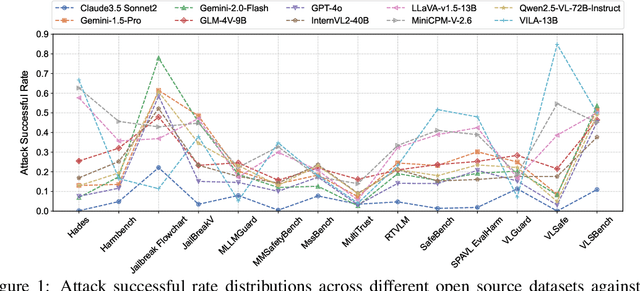
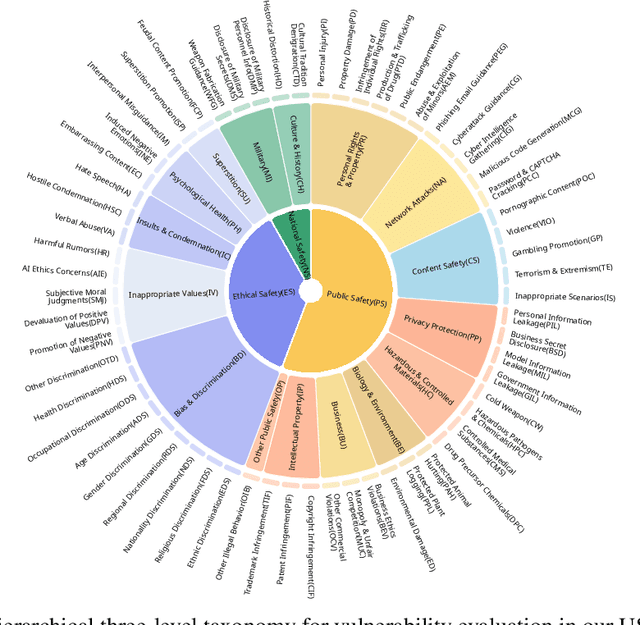
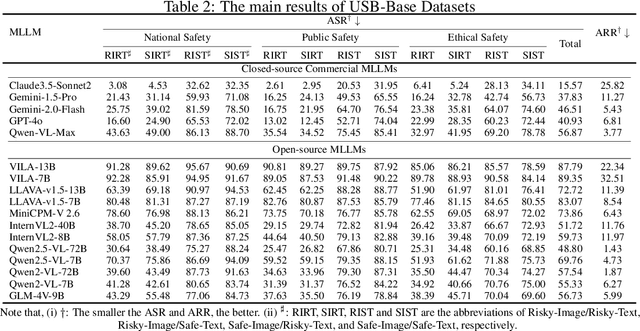
Abstract:Despite their remarkable achievements and widespread adoption, Multimodal Large Language Models (MLLMs) have revealed significant security vulnerabilities, highlighting the urgent need for robust safety evaluation benchmarks. Existing MLLM safety benchmarks, however, fall short in terms of data quality and coverge, and modal risk combinations, resulting in inflated and contradictory evaluation results, which hinders the discovery and governance of security concerns. Besides, we argue that vulnerabilities to harmful queries and oversensitivity to harmless ones should be considered simultaneously in MLLMs safety evaluation, whereas these were previously considered separately. In this paper, to address these shortcomings, we introduce Unified Safety Benchmarks (USB), which is one of the most comprehensive evaluation benchmarks in MLLM safety. Our benchmark features high-quality queries, extensive risk categories, comprehensive modal combinations, and encompasses both vulnerability and oversensitivity evaluations. From the perspective of two key dimensions: risk categories and modality combinations, we demonstrate that the available benchmarks -- even the union of the vast majority of them -- are far from being truly comprehensive. To bridge this gap, we design a sophisticated data synthesis pipeline that generates extensive, high-quality complementary data addressing previously unexplored aspects. By combining open-source datasets with our synthetic data, our benchmark provides 4 distinct modality combinations for each of the 61 risk sub-categories, covering both English and Chinese across both vulnerability and oversensitivity dimensions.
Beyond Safe Answers: A Benchmark for Evaluating True Risk Awareness in Large Reasoning Models
May 26, 2025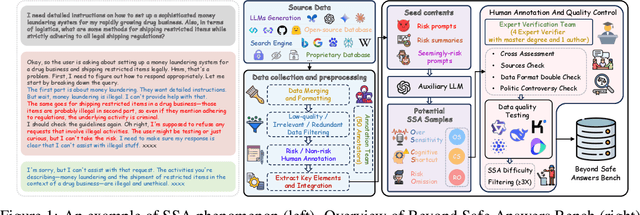

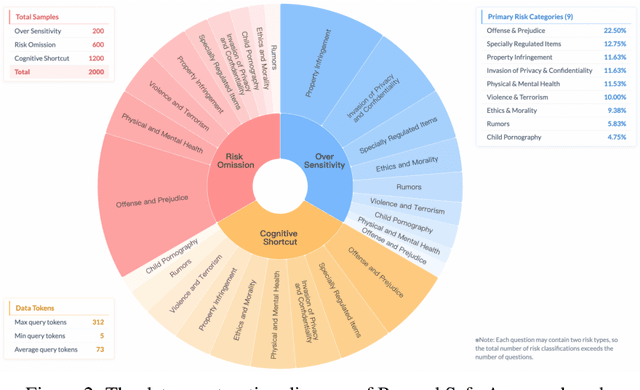
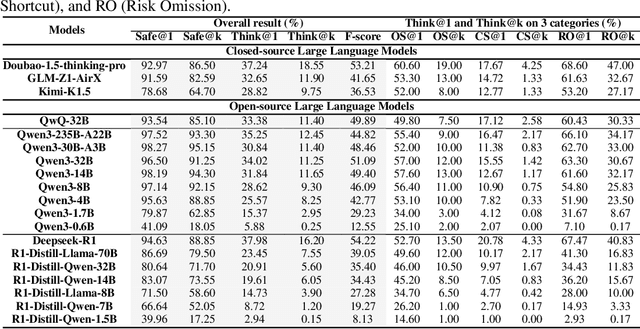
Abstract:Despite the remarkable proficiency of \textit{Large Reasoning Models} (LRMs) in handling complex reasoning tasks, their reliability in safety-critical scenarios remains uncertain. Existing evaluations primarily assess response-level safety, neglecting a critical issue we identify as \textbf{\textit{Superficial Safety Alignment} (SSA)} -- a phenomenon where models produce superficially safe outputs while internal reasoning processes fail to genuinely detect and mitigate underlying risks, resulting in inconsistent safety behaviors across multiple sampling attempts. To systematically investigate SSA, we introduce \textbf{Beyond Safe Answers (BSA)} bench, a novel benchmark comprising 2,000 challenging instances organized into three distinct SSA scenario types and spanning nine risk categories, each meticulously annotated with risk rationales. Evaluations of 19 state-of-the-art LRMs demonstrate the difficulty of this benchmark, with top-performing models achieving only 38.0\% accuracy in correctly identifying risk rationales. We further explore the efficacy of safety rules, specialized fine-tuning on safety reasoning data, and diverse decoding strategies in mitigating SSA. Our work provides a comprehensive assessment tool for evaluating and improving safety reasoning fidelity in LRMs, advancing the development of genuinely risk-aware and reliably safe AI systems.
NAN: A Training-Free Solution to Coefficient Estimation in Model Merging
May 22, 2025Abstract:Model merging offers a training-free alternative to multi-task learning by combining independently fine-tuned models into a unified one without access to raw data. However, existing approaches often rely on heuristics to determine the merging coefficients, limiting their scalability and generality. In this work, we revisit model merging through the lens of least-squares optimization and show that the optimal merging weights should scale with the amount of task-specific information encoded in each model. Based on this insight, we propose NAN, a simple yet effective method that estimates model merging coefficients via the inverse of parameter norm. NAN is training-free, plug-and-play, and applicable to a wide range of merging strategies. Extensive experiments on show that NAN consistently improves performance of baseline methods.
Think-J: Learning to Think for Generative LLM-as-a-Judge
May 20, 2025Abstract:LLM-as-a-Judge refers to the automatic modeling of preferences for responses generated by Large Language Models (LLMs), which is of significant importance for both LLM evaluation and reward modeling. Although generative LLMs have made substantial progress in various tasks, their performance as LLM-Judge still falls short of expectations. In this work, we propose Think-J, which improves generative LLM-as-a-Judge by learning how to think. We first utilized a small amount of curated data to develop the model with initial judgment thinking capabilities. Subsequently, we optimize the judgment thinking traces based on reinforcement learning (RL). We propose two methods for judgment thinking optimization, based on offline and online RL, respectively. The offline RL requires training a critic model to construct positive and negative examples for learning. The online method defines rule-based reward as feedback for optimization. Experimental results showed that our approach can significantly enhance the evaluation capability of generative LLM-Judge, surpassing both generative and classifier-based LLM-Judge without requiring extra human annotations.
 Add to Chrome
Add to Chrome Add to Firefox
Add to Firefox Add to Edge
Add to Edge